

New 3D Printer Uses Lasers to Print Metal Objects in Mid-Air. Overcoming Limitations By Innovation From human bones to jet engine parts, products made through 3D printing technology have been increasingly transforming our world.
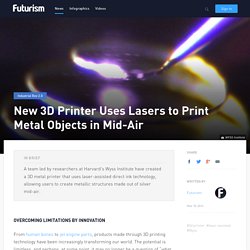
The potential is limitless, and perhaps, at some point, it may no longer be a question of “what else can it print?” But “how else can we print?” In a recent press release, scientists from Harvard’s Wyss Institute for Biologically Inspired Engineering announce that they have just constructed a new 3D printer that could spew out conductive metallic ink at the microscale, possibly leading to more complex architectures and electronic devices.
This Robot Can 3-D Print A Steel Bridge In Mid-Air. In 2017, Dutch designer Joris Laarman will wheel a robot to the brink of a canal in Amsterdam.
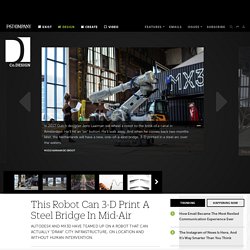
He'll hit an "on" button. He'll walk away. 9 Things I Learned From Attending the World's Largest 3D Printing Conference (HPQ) 3D-printed prototypes from Stratasys.
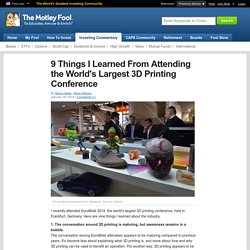
Source: Author. I recently attended EuroMold 2014, the world's largest 3D printing conference, held in Frankfurt, Germany. Here are nine things I learned about the industry. 1. The conversation around 3D printing is maturing, but awareness remains in a bubble. 2. 3. Foam-squirting quadcopter becomes a flying 3D printer. The swiftlet may not look much different than other little birds, but it has one unique ability – it builds its nest out of its own saliva.
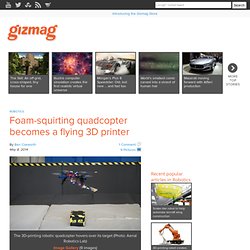
Inspired by the swiftlet, scientists at Imperial College London's Aerial Robotics Lab have created a robotic quadcopter that can extrude polyurethane foam while in flight. By targeting where that foam goes, it can build up simple structures, essentially becoming a flying 3D printer. The technology could have some very important applications. View all Developed mainly by Graham Hunt and other members of a team led by Dr. In its current form, the aircraft uses GPS and an external system of 16 infrared cameras to identify targets upon which to spray the foam, within an indoor lab.
Down the road, however, Kovac's team hopes to create fully-autonomous UAVs equipped with their own high-speed cameras and 3D depth senors, that could function in a variety of chaotic, real-world conditions. Mazzo di Fiori & the Next Generation 3D Printer by Joshua Harker. Cut Copy's gorgeous new music video takes 3D printing to new territory. The First 3-D Printed Book Cover Is Here. It was only a matter of time: the first 3-D printed book cover has arrived.
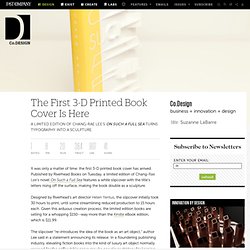
Published by Riverhead Books on Tuesday, a limited edition of Chang-Rae Lee’s novel On Such a Full Sea features a white slipcover with the title’s letters rising off the surface, making the book double as a sculpture. Designed by Riverhead’s art director Helen Yentus, the slipcover initially took 30 hours to print, until some streamlining reduced production to 15 hours each. Given this arduous creation process, the limited edition books are selling for a whopping $150--way more than the Kindle eBook edition, which is $11.99. 3D Printing. You are in: Future Technologies : 3D Printing 3D Printing Imagine a future in which a device connected to a computer can print a solid object.
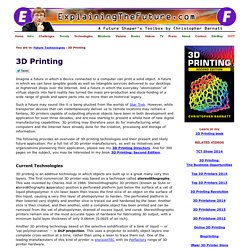
Scientists 'print' new eye cells. 17 December 2013Last updated at 19:54 ET By Michelle Roberts Health editor, BBC News online Many teams are researching different ways to repair the sight-giving cells of the retina Scientists say they have been able to successfully print new eye cells that could be used to treat sight loss. The proof-of-principle work in the journal Biofabrication was carried out using animal cells. The Cambridge University team says it paves the way for grow-your-own therapies for people with damage to the light-sensitive layer of tissue at back of the eye - the retina. More tests are needed before human trials can begin. 3D printing will explode in 2014, thanks to the expiration of key patents - Quartz.
Here’s what’s holding back 3D printing, the technology that’s supposed to revolutionize manufacturing and countless other industries: patents.
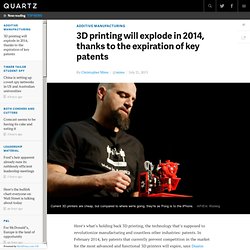
In February 2014, key patents that currently prevent competition in the market for the most advanced and functional 3D printers will expire, says Duann Scott, design evangelist at 3D printing company Shapeways. These patents cover a technology known as “laser sintering,” the lowest-cost 3D printing technology. Because of its high resolution in all three dimensions, laser sintering can produce goods that can be sold as finished products. Whenever someone talks about 3D printing revolutionizing manufacturing, they’re talking about the kinds of goods produced by, for example, the industrial-grade 3D printing machines used by Shapeways.
The company used by countless industrial designers, artists and entrepreneurs who can’t afford their own 3D laser sintering printers, which can cost tens of thousands of dollars each. A very cool new video: A brief introduction to 4D printing. It’s not often that you see a designer throw their creation on the ground and break it to smithereens.
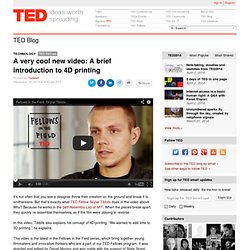
But that’s exactly what TED Fellow Skylar Tibbits does in the video above. Why? Because he works in the Self-Assembly Lab at MIT. When the pieces break apart, they quickly re-assemble themselves, as if the film were playing in reverse. In this video, Tibbits also explains his concept of 4D printing. Maybe We're Making It Too Easy For The Machines To Take Over. This article is part of ReadWrite Future Tech, an annual series in which we explore how technologies that will shape our lives in the years to come are grounded in the innovation and research of today.
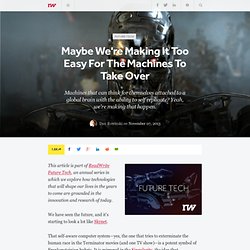
We have seen the future, and it's starting to look a lot like Skynet. That self-aware computer system—yes, the one that tries to exterminate the human race in the Terminator movies (and one TV show)—is a potent symbol of Frankensteinian hubris. It is mirrored in the Singularity, the idea that technological progress will soon hit exponential growth, leading to self-aware robots and artificial intelligence that seize control of their own destiny, rendering humans irrelevant if not extinct.
(Unless people go transhuman first, although that's another article entirely.) 10 Reasons to be Bullish About the 3D Printing Industry.